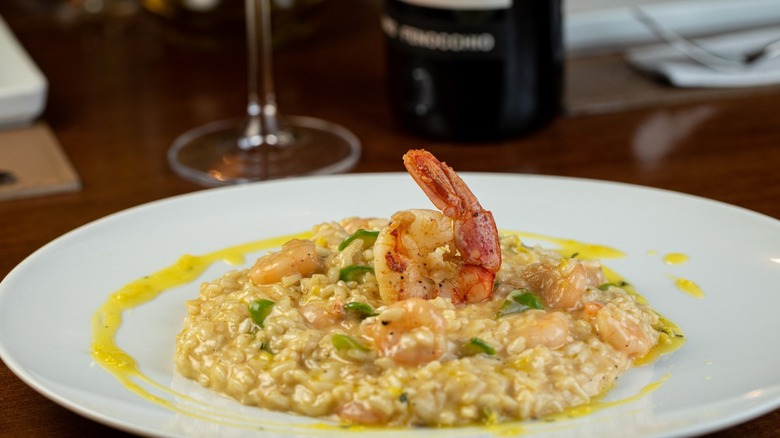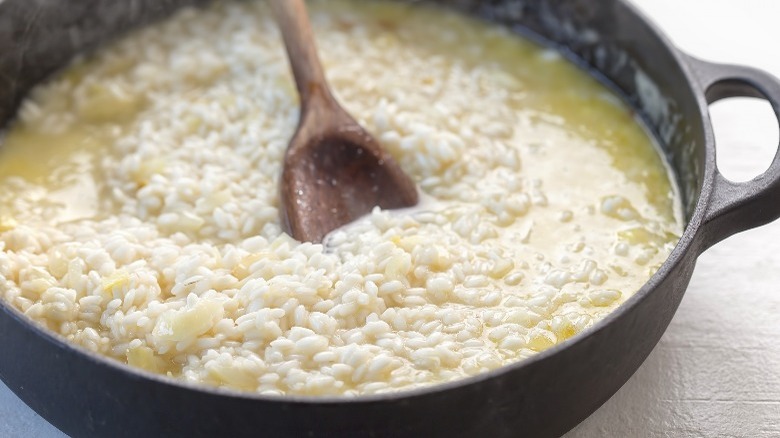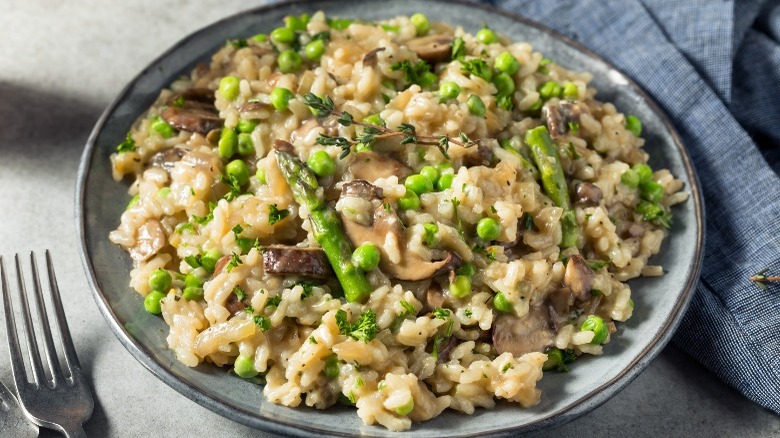The Absolute Best Wine Substitute When Making Risotto
Risotto is one of those dishes that on paper sound easy enough. In fact, Cooking Light recently summed risotto up as just rice and broth. But in actual practice, it is really so much more. True, the basics of the dish are short grain rice (arborio, vialone nano, or carnaroli) coated in olive oil and ever-so-lightly toasted in a pan, then a soffrito of finely diced aromatics like onion, celery, carrot, garlic, and herbs are sauteed in olive oil (think an Italian version of mirepoix). Both are then cooked slowly with ladle-by-ladle full of heated broth, stirred slowly and frequently, though not constantly, over low-medium heat, and finished with parmesan.
There are many variations of risotto, from what broth or herbs you use, to what meats or vegetables you may add, whether you deglaze the pan with wine or broth, finish with only parmesan, or add cream and/or butter to your final stir. In this way, risotto is more than a singular dish, it is a time-honored tradition, imbued with the folklore and history of those who have cooked it before. More accurately though, it is best described by Italian-American celebrity chef, Lidia Bastianich, as she did in her 2017 Harvard lecture, The Science of Risotto as "An Italian technique of cooking rice."
An improvisational dish
There are lots of ways to go wrong with risotto, notes Bon Appetit, but master the technique and you can play with flavors and ingredients, coaxing out all its possibilities, and making the dish all your own. That's the beauty of risotto; the ability to play. If you run out of something, fear not, for something else can be substituted and it will not only still be delicious but you might just find a new favorite. As they say, necessity is the mother of invention, so take this opportunity to invent a new path for your risotto.
This is why, when making risotto, unless you are missing the rice or the cooking liquid (which, in truth, could just be water), it's best to remember — anything goes. And while many risotto recipes call for wine to enhance or compliment certain flavors and balance the dish with a bit of acidity, it is not necessary in order to make a delicious risotto. So, what do you do if you realize you're all out of wine in the middle of cooking your risotto? Improvise!
Wine substitutes for risotto
The first option is to not substitute the missing wine at all, opting for a bit more broth. Many basic risotto recipes do not even include wine. But, if you do, be prepared, as it is the wine's natural acidity that helps penetrate the starchy grain, infusing flavors and adding balance to the dish.
Some of the most common substitutions used to replace the acidity of wine in risotto are other alcohols (like dry sherry, vodka, or gin). Just a squeeze of citrus fruits like lemon and lime can help to brighten the dish, notes Substitute Cooking. Even a bit of unsweetened grape or apple juice can lend another layer of complexity to your risotto.
But the easiest replacement is often the one most readily available to a home cook — a splash of vinegar. Depending on the type and quality of your vinegar, this substitute can really liven up the flavors in your risotto, complimenting ingredients already in place. Try adding sherry vinegar for mushroom risotto, white or red wine vinegar in place of white or red wine, or even rice or apple cider vinegar to boost the taste in asparagus risotto. Just be sure not to overdo it. A little vinegar goes a long way — remember, you're looking for balance, not a sour, overpowering tang.


